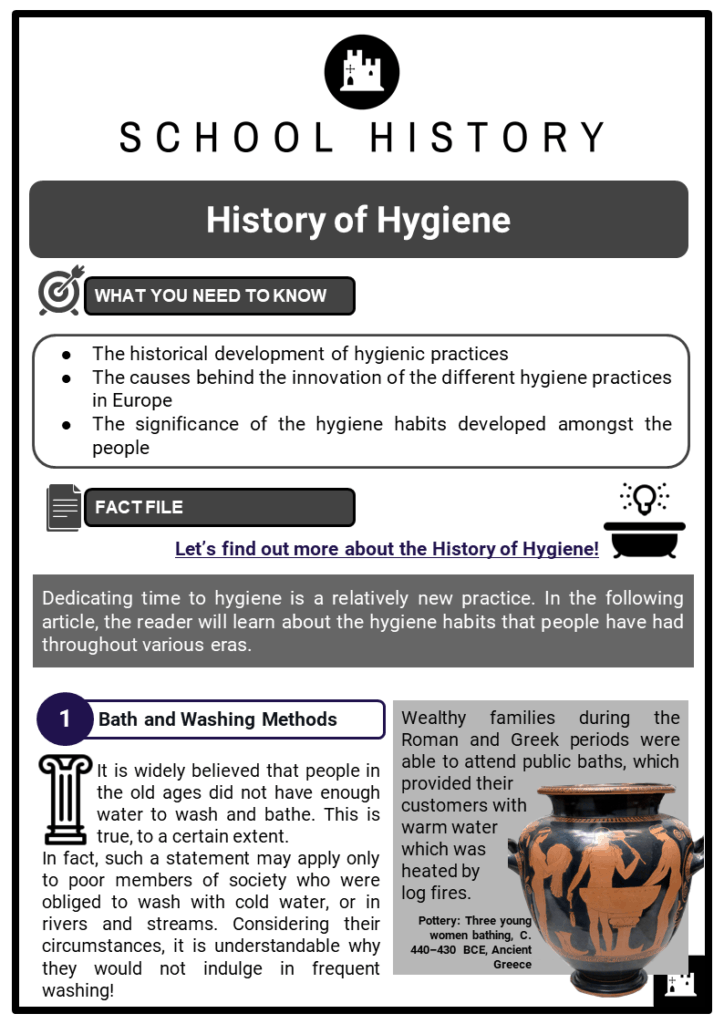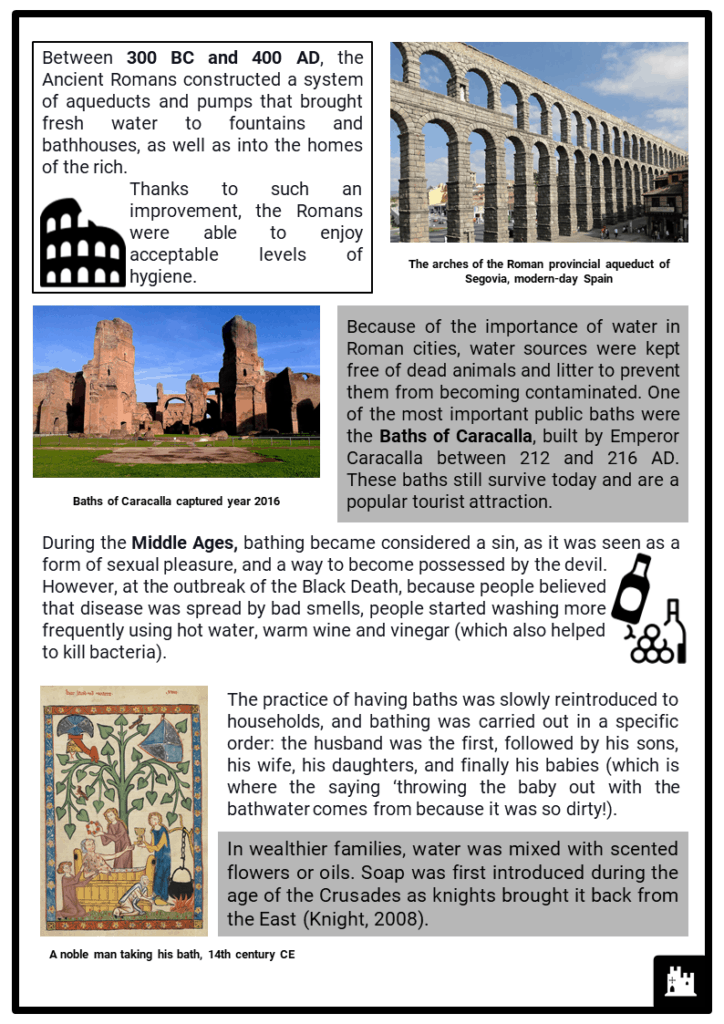Download History of Hygiene Worksheets
Do you want to save dozens of hours in time? Get your evenings and weekends back? Be able to teach History of Hygiene to your students?
Our worksheet bundle includes a fact file and printable worksheets and student activities. Perfect for both the classroom and homeschooling!
Table of Contents
Add a header to begin generating the table of contents
Summary
- The historical development of hygienic practices
- The causes behind the innovation of the different hygiene practices in Europe
- The significance of the hygiene habits developed amongst the people
Key Facts And Information
Let’s find out more about the History of Hygiene!
- Dedicating time to hygiene is a relatively new practice. In the following article, the reader will learn about the hygiene habits that people have had throughout various eras.
Bath and Washing Methods
- It is widely believed that people in the old ages did not have enough water to wash and bathe. This is true, to a certain extent.
- In fact, such a statement may apply only to poor members of society who were obliged to wash with cold water, or in rivers and streams. Considering their circumstances, it is understandable why they would not indulge in frequent washing!
- Wealthy families during the Roman and Greek periods were able to attend public baths, which provided their customers with warm water which was heated by log fires.
- Between 300 BC and 400 AD, the Ancient Romans constructed a system of aqueducts and pumps that brought fresh water to fountains and bathhouses, as well as into the homes of the rich.
- Thanks to such an improvement, the Romans were able to enjoy acceptable levels of hygiene.
- Because of the importance of water in Roman cities, water sources were kept free of dead animals and litter to prevent them from becoming contaminated. One of the most important public baths were the Baths of Caracalla, built by Emperor Caracalla between 212 and 216 AD. These baths still survive today and are a popular tourist attraction.
- During the Middle Ages, bathing became considered a sin, as it was seen as a form of sexual pleasure, and a way to become possessed by the devil.
- However, at the outbreak of the Black Death, because people believed that disease was spread by bad smells, people started washing more frequently using hot water, warm wine and vinegar (which also helped to kill bacteria).
- The practice of having baths was slowly reintroduced to households, and bathing was carried out in a specific order: the husband was the first, followed by his sons, his wife, his daughters, and finally his babies (which is where the saying ‘throwing the baby out with the bathwater comes from because it was so dirty!).
- In wealthier families, water was mixed with scented flowers or oils. Soap was first introduced during the age of the Crusades as knights brought it back from the East (Knight, 2008).
- Moving into the 16th century, being a trendsetter in fashion and culture, Queen Elizabeth I is believed to have said, ‘I bath once a month, whether I need it or not.’ There is no primary historical evidence to substantiate this claim and it does not mean that the queen did not wash.
- In the 19th century, poorer people would regularly wash their hands, feet, and face, but would only wash the rest of their body a couple of times per month (if not less).
- On the other hand, in Regency England, Beau Brummell – an aristocrat and icon for male fashion – popularised the habit of bathing amongst the upper echelons of society by having a bath every day and claiming that people should always smell good without having to employ perfumes and the like.
Teeth
- N. Wadsworth patented the toothbrush in 1857,
- in which he used swine hair and animal bone. However, early forms of toothbrushes had already appeared.
- Before this, the teeth of both upper and lower classes of society were brown and prone to rot easily but people employed various techniques to brush their teeth.
- During the Medieval period, individuals would (I) rub their teeth with a cloth in order to remove tartar and other food particles that appeared; (II) use herbs and leaves ‘soaked in orange flower water and mixed with musk’; (III) use water or a mixture of vinegar in order to remove gunk from their mouth; (IV)chew on herbs such as ‘mint, cloves, cinnamon, sage’ (Knight 2008).
- There was no such thing as a dentist and often the local barber would extract teeth and/or make fillings.
- During the Elizabethan era, rubbing teeth with the ashes of burnt rosemary was a very popular option. However, sage was also used in order to whiten teeth, whereas vinegar and wine were employed as mouthwash due to their disinfectant qualities.
- During the Renaissance and the Regency period, the same techniques were used. However, during Regency England, the French dentist Fouchard advised washing one’s mouth with one’s urine (Knight 2008).
- By the 18th century, the first denture was made with porcelain.
Household Habits
- Because of hygiene habits during the Middle Ages, it was not uncommon to be bitten by lice and fleas: in fact, they were carriers of infections and the poor were highly exposed to their danger due to their bad eating habits.
- A simple bite could lead to the lowering of one’s immune system and the subsequent spreading of other diseases such as typhus and tapeworms (Howell 2013).
- People covered the floors of their homes with straw and ‘sweet-smelling wildflowers and herbs to fragrance the room’ (Howell 2013) in order to hide filth and dirt which remained untouched for decades at times.
- In fact, following his journey to England in the XVI century, Erasmus wrote: ‘The floors are, in general, laid with white clay, and are covered with rushes, occasionally renewed, but so imperfectly that the bottom layer is left undisturbed, sometimes for twenty years, harbouring expectoration, vomiting, the leakage of dogs and men, ale droppings, scraps of fish, and other abominations not fit to be mentioned. Whenever the weather changes a vapour is exhaled, which I consider very detrimental to health’ (Howell 2013; citing Erasmus).
- In essence, dirt was not cleaned, and homes often became a breeding ground for bacteria and rats.
Toilets and Disposal of Waste
- In the Roman era, not only were toilets public, but they were also a great place to meet new people and to socialise (after all, they must have been one of the most frequented places in the city!). Although in our times this seems shocking, for the Romans it was a perfectly normal habit and they would not mind carrying out their physical duties in public latrines (i.e. toilets).
- For those who preferred to be more private, there existed smaller latrines which could contain up to ten people; other larger latrines could have a capacity of more than forty people. The Roman sewage system was characterised by quite complicated engineering.
- During the Tudor era, toilets were anything but fancy: they were called ‘privies’ and consisted of a bowl placed underneath a wooden box with a hole carved in its top. Such a toilet was hidden in a garderobe, i.e. a large cupboard. At times there was no bowl beneath the slab of wood, and instead, there would be a hole in the ground which directed the waste into a moat (a wide ditch that surrounded a castle).
- The said practice was reserved only for the upper members of society. In fact, the lower classes were obliged to bury their waste. Toilet paper was not yet in use, therefore as a replacement, rich people employed lambswool, whereas the poorest used ‘leaves or moss’ (Howell 2013).
- Kings and Queens had someone who would wipe their bottom for them, and such a job was officially called the ‘Groom of the Stool’ (Howell 2013). Although this may seem a terrible job, during the Tudors era, it was a highly regarded position since it would allow them to become one of the monarch’s closest confidants and friends with a possibility of advancement.
- Although flushing toilets were invented in the late 1590s by Sir John Harrington, they became popular only in the second half of the 19th century. Harrington was Elizabeth I's godson, and the Queen had one of these new inventions installed in her court.
- In the late 1880s, toilets became water closets since they contained water and flushed waste away.
Hair and Makeup
- In their cosmetic practices, Ancient Egyptians employed much kohl and lead which would at first cause irritation and subsequently mental illnesses. They would use such products in order to make face powder and eye shadows.
- The Romans and Greeks did the same and used lead with the intention of lightening their skin. However, the continuous use of such substances caused skin ruptures, as well as infertility and madness.
- Lead was not used exclusively by ancient civilisations. In fact, during the Elizabethan period, women sought to attain a pale face which symbolised purity and conformed to the beauty standards of the time. However, they did so by employing dangerous lead powder which could be easily found on the market. Although such powder provided a ‘silky matte finish’, it could cause ‘brain swelling, paralysis, and multiple organ failure’ (Pillai 2015).
- Throughout the Georgian period in England, and the Revolution era in France, wigs were very in vogue. Being incredibly fashionable, they were reserved for aristocrats and royalty. In fact, prestigious wigs were made with real human hair, whereas cheaper versions involved the use of animal hair such as horse or goat hair.
- It is worth noting that the big coiffures were heavy and big: their weight often caused people to develop sores on their scalp. Moreover, not only were wigs home to lice and other insects, but they could also catch fire relatively
easily, since they were styled with animal fat.






